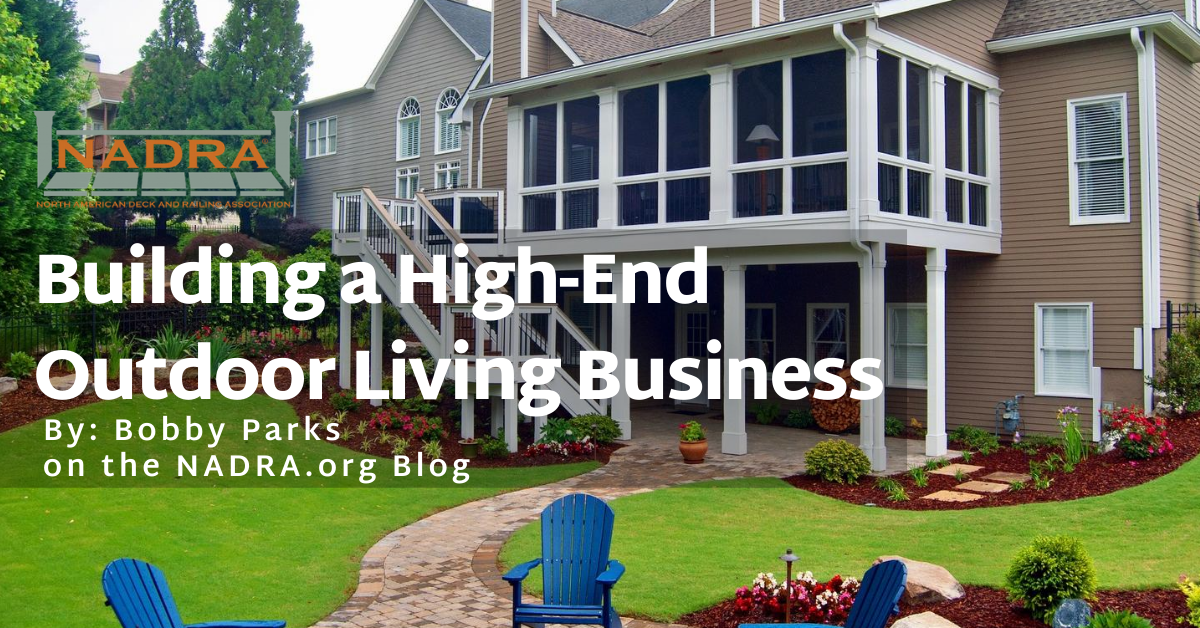Most of the deck building contractors I know can be broken down into two main business categories or groups. One category includes “deck building” contractors who focus primarily on offering decks and deck accessory products. This group includes owners who work within their crew as well as others who position themselves to run several crews. They fill a very niche-specific role with variations that include contractors covering deliveries from the lower to high-end projects. They can design and build the “deck” but if a homeowner wants additional options or an expanded outdoor build the customer may have to use a different contractor that provides more outdoor options or use additional contractors that specialize in a particular field. With the latter, the homeowner ends up serving as the general contractor for their project taking on a role they’re not familiar with or comfortable with.
The second group includes contractors that perfected the deck building aspects or another specific outdoor project type and then expanded offering a wider range of outdoor living options using more of a remodeling and general contractor template as an “outdoor living contractor”. They are willing to organize and coordinate additional outdoor features along with their deck building designs through the use of subcontractors or in-house tradespeople. This may include limited hardscapes, outdoor kitchens, fireplaces, fire pits, and amenities that require specialty contractors. They are willing to schedule and supervise trades such as painters, roofers, gutter, stone, plumbing, and any necessary items to deliver a job. They’re offering larger-scale projects that require teams and organizations to deliver and usually a higher volume of both annual dollars and projects. They provide a level of comfort and convenience to the customer in that they can provide a turn-key service beyond deck building. And they provide themselves with a way to add to their bottom lines each year with some type of margin off of the additional outdoor options they organize and provide. They are not doing this for free. Most don’t do this in-house or with their carpenters but do it in a way that simply requires building a team of subcontractors that see the benefit in working with a contractor that provides them multiple jobs throughout the course of a year. This can provide a way for annual monetary growth without an increase of overhead and employees, as subs are used on an as-needed basis. More than likely most in this group didn’t enter the expanded outdoor living program until they were many years into their businesses.
The top players in both of the pre-mentioned categories set the bar and stand out as an inspiration to others that strive to achieve a similar level in the industry. We see many of these operators on Instagram and Facebook. Although most differ in how they operate, the best have similarities in that they take care of their customers, have adopted high quality build standards, use premium materials, and are creative with designs. The personal mental make-up of the top contractors in each segment includes an inner drive, high standards of excellence, and most are trendsetters and leaders in their markets. Most have taken chances and have a history that includes trial and error. They were likely grinding gears earlier in their careers but have figured out how to shift smoothly and now have rhythm. And most earned this position and receive recognition because of the delivery history they created in terms of both projects and successful business longevity. None assumed this position overnight and it took years to get to where they are now. The truly successful ones in each arena have learned to communicate and sell value, developed a brand, reputation, and learned to leverage off credibility to be profitable. They are not complacent and continue to strive to improve with business systems and techniques. You’ll see some, but not all, at the NADRA Deck Awards banquet each year.
The best are ambitious, motivated, and work hard and smart. They believe in what they offer and develop confidence in selling the vision, value, and dream to customers. They take tremendous pride in what they do and they don’t settle for being like everyone else. These contractors challenge themselves with an inner drive to improve in every way possible. They didn’t choose the simple path when it comes to project deliveries. Instead, they chose a more challenging path and followed it. The ones that have positioned themselves to grow their businesses have learned that their hands don’t have to be on the work delivered and that what’s important is that they assure a consistent delivery that maintains their quality standards. The really organized ones incorporate contractor management programs that allow them to track job progress and communicate efficiently with others involved in the construction management side of the business.
Very few if any have hit this mark by building simple low-end projects. They realize the easier something is to do the more they are capable of doing it which usually means that there is less money to be made. I’m not saying you can’t have a successful business with a production model – it is possible. But that comparison is for another day and writing. All of the ones that I know have made it by navigating over time by being creative, providing great customer service, and using higher-end products.
For me personally it was about incorporating a building philosophy of what I wanted to deliver and be known for. It was about creating a basic build standard that ranked high on the chart. It was about combining materials I believed would perform the best with PVC being one of a few in the recipe. I wanted all jobs to create a positive long term reflection on me and the company’s reputation. I wanted to be known for delivering a certain type of project and produce long term referrals by building jobs that performed for years after the build. It was a simple process of building a brand and reputation one customer at a time and through the leveling of websites and internet strategies. I recognized that there is a limited buildout capacity for each contractor including myself and I wanted to maximize profit for every job that was put on the job board. And I wanted to create the lead opportunities that allowed me to impose a profitable price tag compared to limited lead opportunities where I might be reluctant to do the same.
I also wanted to assist and offer projects with options to homeowners that wanted more than a deck without them having to feel like they would need to GC the job. I was willing to offer a limited menu of hardscapes options such as flagstone, pavers, stamped concrete, fire pits, small retaining walls, and stone bases. These were items that required finding a good company or subcontractor that I could trust to handle the delivery and communicate properly with a customer. And it required that the wholesale price from them allowed me to work retail margins in for myself. Not a full margin like the decks and porches but it allowed for a way to increase bottom-line annual profits leverage if an existing business structure without requiring me to add any overhead or employee cost.
To the young guns or newer operators, you should realize that there are many benefits in raising the bar if you’re not already delivering higher-end jobs and expanding your offerings. To rise in either, you have to develop your people skills and sales ability to match your building skill levels. You have to communicate your credibility and abilities to deliver projects. Practicing the basics of professionalism is a must.
When it comes to higher-end options such as composite or PVC decking, railings, and lighting, it is not as difficult to help customers understand the benefits and not as hard to sell high as some seem to think. Markets and customer budgets and desires vary but for those that want performance, quality, and are willing to invest, it is a great option. Sometimes I believe the conflict with “price” is more in a contractor’s head than a customer. If you believe in something and present it with confidence and passion it shines through to a customer. Whereas the doubt and lack of confidence do exactly the opposite and keep the higher-end options from being sold as the customers read us like a book. It is hard to sell what you don’t believe. In many cases when we’re first establishing ourselves in a market we, ourselves can’t even afford. Because of this, some don’t believe others can afford it either. This doubt taints our minds and it plays in our heads consciously or unconsciously and shows through when you’re in front of a customer. Realizing market demographics vary comes down to finding the customers that are willing to invest and appreciate the long term aspects of higher-end items such as PVC or Composites etc. It also comes down to your personality, how well you listen, and how well you communicate with your customers.
You may focus on wood decks and a limited delivery now but once you’ve perfected your systems and processes you can consider an expansion depending on your market demand and availability of subs or labor to deliver it. Operating a business involves a maturity that comes with experience that allows for progression and efficiency. You can be successful in delivering decks and deck accessories only and never have to venture into more of a general contracting world if that’s what you want. What’s important is that you maximize your reputation with whatever you’re doing which allows for maximized profitability and business stability.
A higher-end delivery history involving better performing products will improve your reputation as a contractor, aide you with future sales, reduce buyers’ remorse, and allow for increased profits if you gain the confidence to charge the right prices. It provides long term referrals more consistently than lower-end work will ever do. Achieving such levels takes time, requires setting goals, and a consistent effort. You may have to offer a good, better, best option but convert as many as you can over time to the better projects. No doubt selling a higher-priced project has its challenges but the higher percentage of conversions you have compared to lower-end jobs the better off you’ll be. And although it can be slow to establish yourself as their best choice to deliver better jobs in a market, it gets easier as you progress and have numerous job deliveries to leverage off of. Showing photos of such work lends credibility and creates comfort levels with customers.
Learning the business side will be a necessity to ever earn more than good wages. Businesses of all types- progress, evolve, and require adjustments over time. Your ambition and ability to adapt and gain business balance will affect the long term outcome. It’s what’s in your head and the confidence or lack of it that allows or limits progress. Over time being able to wean yourself out of the crew for at least part of the time will offer benefits that you’ll not likely reap as a full-time crew member.
So the path you choose, whether it is to focus strictly as a deck builder or expand your offerings over time, whether you remain an integral part of the crew and production or work yourself out of it over time, there is a recipe for success. Although there are similar ingredients, the recipes for each are different. Whichever you choose you should max out the potential in terms of reputation and project types. And you should create a business model that allows for the best chance of success and profitability. It will be impacted by the decisions you make, how well you navigate over time, and how well you take care of your customers and your team members along the way. The key is to excel and rise to the top of whichever category you operate in.




